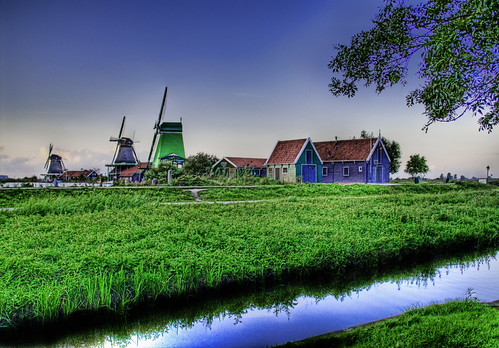
Photo by Trey Ratcliff used under a Creative Commons license.
Gerbrand Bakker, The Twin (Vintage Books (London), 2009).
Helmer van Wonderen, the narrator of this novel, is the surviving half of twins, now in his late fifties and living in a farmhouse in north Holland, near the IJsselmeer, with his father, who is slowly dying. Helmer has been a prisoner of events decades earlier, particularly the death of his brother Henk. Then Henk’s fiancée returns, asking Helmer if her disenchanted teen-age son, also named Henk, can come and live with him. Both are trapped in unhappiness, but is there the possibility of change?
Here are Wikipedia’s pages on the author and the book, which won the 2010 International IMPAC Dublin Literary Award. NPR offers an excerpt. The Complete Review says little happens, and even major events seem almost incidental, but it is an absolutely fascinating read. Catherine Taylor (The Guardian) says loneliness and the beauty of the landscape create an atmosphere of inchoate yearning. Nicola Barr (The Guardian) calls it a novel of lost chances, of lost lives, of sadness and regret. Paul Binding (The Independent) says it’s a novel of great brilliance and subtlety. Susan Salter Reynolds (Los Angeles Times) says Bakker’s writing is so fabulously clear that each sentence leaves a rippling wake. If you can access their archive, Tim Parks reviewed it in The New York Review of Books. The NLPVF says it’s ostensibly a book about the countryside, seen through the eyes of a farmer. Gavin (Page 247) saw themes and characters which were mythic in scope by completely rooted in the reality of daily work and a brilliantly realized sense of place. Anne Posten (The Quarterly Conversation) says it cannot be said to be innovative, yet is unique and surprising for the depth it finds in a quiet tale of pastoral realism. Kevin thinks very few books explore interpersonal relationships as well. Trevor knew he’d return to it. Chad W. Post (Three Percent) found Bakker’s prose mesmerizing, lyrical and understated. Danny Yee appreciates the strong sense of time and place in the seasonal and daily rhythms of a small farm near the IJsselmeer. Lisa Hill calls it deceptively simple. Randy Boyagoda (The Globe and Mail) calls it unapologetically slow-paced, patient in its revelations. Sue Magee was reminded of Coetzee or a more structured Ondaatje. Jeremy Nussbaum compares Bakker to Chekhov. Douglas Messerli describes the plot in detail (n.b. – spoilers). Jeannette Cooperman says it is a book you feel in your bones, and one that blooms where least expected. Emily had fun reading it as a piece of Gothic fiction. Plume of Words calls it a perfectly paced, insightful novel whose rhythms lull you into something like wonder, and says that it makes possible the sense of strangeness, of traveling into a different cultural mindset. Elinor Teele (California Literary Review) says there is something so peculiarly Northern European about it that one has a hard time trying to describe it without quoting half the book. Winstonsdad says the descriptions of the platteland scenery impart isolation and strangeness. William Rycroft says the descriptions of rural life and the Dutch countryside have a poetic beauty without obvious poetic flourishes. 3GoodRats calls it a novel of intense loss and suppressed rage. Carlos Amantea says Bakker has solved the problem of making a dull life interesting. Tommy Wallach (The Arts Fuse) says it renders static solitude dynamic and readable. Keep cool, Wendy. Amos Lassen was deeply touched. Tim enjoyed reading and contemplating. Amy found an unexpected surprise at the end. And Renate, Simone and Jilles, the fiction buyers at the American Book Center stores in Amsterdam and The Hague, explain why they stock it and other Dutch authors in English translation; they call The Twin an ode to the flat and bleak Dutch countryside, with its ditches and its cows and its endless grey skies. Watch Bakker tell you a little something about the novel. Stephen finds Bakker being interviewed by Eileen Battersby in the Irish Times. Ramona Koval interviewed Bakker for Australian radio.








